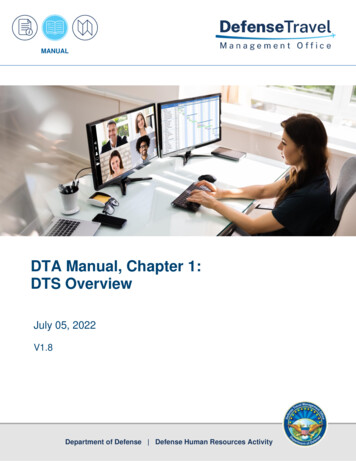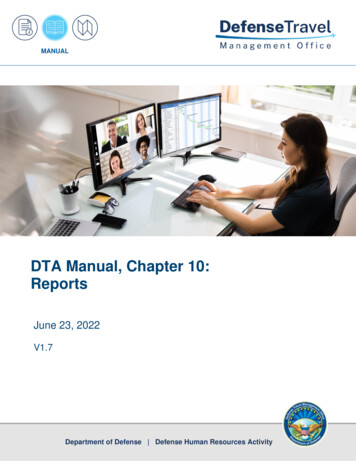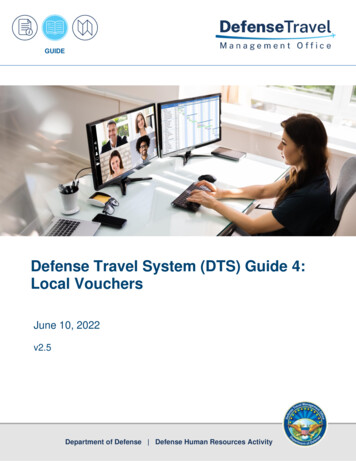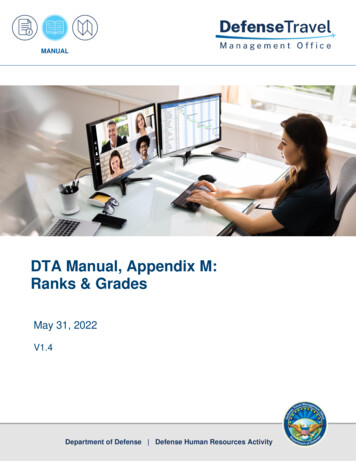
Transcription
MANUALDTA Manual, Chapter 1:DTS OverviewJuly 05, 2022V1.8Department of Defense Defense Human Resources Activity
DTA Manual, Chapter 1: DTS OverviewJuly 05, 2022Table of ContentsRevision History . 2Chapter 1: Defense Travel System (DTS) Overview . 3Chapter 2: DTS User Types and Roles . 42.1 DTS User Profile.42.2 DTS User/Traveler Profile .42.3 Defense Travel Administrators (DTAs) .42.4 Reviewing Officials .42.5 Traveler .5Chapter 3: DTS Architecture . 5Chapter 4: Trip – Planning Process . 54.1 Travelers Who Can Access DTS .54.2 Travelers Who Cannot Access DTS .7Chapter 5: Document Lock . 85.1 Document Lock Notifications .85.1.1 Error Messages .95.1.2 Status Notification Email .95.2 Document Lock Admin .9Chapter 6: DTS Training Resources . 126.1 Training Resource Lookup Tool .126.2 Travel Explorer (TraX) .12Chapter 7: Help for DTS. 14Chapter 8: The DTA Manual: Contents & Links . 15Defense Travel Management Office1
DTA Manual, Chapter 1: DTS OverviewJuly 05, 2022Revision ision/Change Description1.004/25/18Defense TravelManagementOffice (DTMO)Changed format, updated language& screenshotsAll1.106/22/18DTMOUpdated URLs to “https” vs. “http”Removed DTS Help For This ScreenThroughoutSection 7.11.208/17/18DTMOUpdated for DTS DashboardSection 5.21.301/04/19DTMOUpdated Document Unlock processSection 5.2Updated Return to DocumentListing sectionUpdated working form OK toUnlockUpdated Training linkPage 10AllSection 5Section 6Section 71.408/12/19DTMOPage 13Page 151.510/23/20DTMOGeneral reviewUpdated screenshotsUpdated TraX and Passport dataUpdated DTS Help Process1.611/12/20DTMOChange Table of Contents formatPage 21.712/31/20DTMOUpdated Dashboard screen shotsSection 5.2Page 11Re-formatted, added new templateUpdated screen shots and addednew wordingAllThroughout1.807/05/22Defense Travel Management OfficeDTMO2
DTA Manual, Chapter 1: DTS OverviewJuly 05, 2022Chapter 1: Defense Travel System (DTS) OverviewDTS is the DoD’s fully integrated, electronic, end-to-end travel management system for processing TemporaryDuty (TDY) travel documents supporting travelers, Authorizing Officials (AOs), and Defense Travel Administrators(DTAs). It is available for Service members, DoD Civilian employees, a dependent of a Service member or Civilianemployee and an invitational traveler. The information paper, Who May Use DTS provides more details forsystem use.In addition to supporting document processing, reservation booking and ticketing requirements, and timelypayments, the system contains specific programing to adhere to the Joint Travel Regulations (JTR) policy ontravel and transportation allowances. DTS generates Pre-Audits and Reason Codes requiring justification for theselection when travelers choose other than the regulatory requirements (e.g., larger rental car, or declines DoDLodging when available). The system gives the AO the ability to return a document for correction when notwithin compliance, limit reimbursement for transportation (not cost effective), or approve the trip based uponthe traveler’s selections, policy, and the mission needs. For more information about AO responsibilities, see theDesktop Guide for AOs/COs. DTS also provides numerous reporting tools allowing DTAs to readily and effectivelymanage their organization’s Pre-Travel and Post-Travel needs and support Travel Audits for compliance. You’llfind out much more about the different reports, in the DTA Manual, Chapter 10.To access DTS the user must have a CAC to log in and sign documents, a profile attached to an organization, afully compatible web browser (e.g., Chrome, Firefox, or Edge), enabled browser pop-ups and cookies, along withDBsign (used for signing and authenticating to web based applications), and JAVA (see your local IT forapplication and version) loaded on their pc. See the DTS Home page for First Time Users.DTS is available at all times to create two primary types of travel documents – authorizations and vouchers –both of which have two sub-types: Authorizations. Before a trip begins, an authorization provides the tools to book reservations, estimatetrip expenses, request advance or monthly payments, and receive approval to travel. The system alsoallows travel managers to review and approve official travel documents, and integrates with variousaccounting systems to pay post-travel claims. A group authorization is also available to simplify theorder creation process for personnel who are traveling together. Vouchers. After official travel ends, the traveler files a voucher to claim reimbursement of expensesand payment of allowances, as well as to split disburse their payments to both their personal bankaccounts and the Government Travel Charge Card (GTCC) vendor. A different voucher type is availablefor travel within the local area.For a more comprehensive introduction to DTS, see the information paper DTS Background. To access the DTSGuides 2– 5 and learn how to create authorizations, vouchers, local vouchers, and group authorizations, visit theDTMO’s main Training page, Resource Lookup Tool which contains many information papers, guides, manuals,and trifolds.This chapter introduces you, the Defense Travel Administrator (DTA), to DTS and the personnel it serves.Defense Travel Management Office3
DTA Manual, Chapter 1: DTS OverviewJuly 05, 2022Chapter 2: DTS User Types and RolesPersonnel who use DTS can be defined in two broad ways: by the type of DTS profile they have (see the DTAManual, Chapter 7: People) and by the roles they perform.2.1 DTS User ProfileA DTS User profile contains information that allows a travel manager or administrator to perform specializedDTS functions, such as accessing another person’s official documents or updating an organization’s routing lists.Personnel who interact with DTS, but never perform official travel have a DTS User profile. Although othersexist, the roles that most commonly need a DTS User profile include DTAs and Reviewing Officials. See Sections2.3 and 2.4 for more information about these roles. Personnel who interact with DTS on behalf of one or moretravelers, such as a travel clerk or a Non-DTS Entry Agent (NDEA), may also have a DTS User profile. See Section2.5 for more information about them.2.2 DTS User/Traveler ProfileA DTS User/Traveler profile contains information that allows a person to travel, such as GTCC and EFT to supportreservations and payments along with options to enter travel preferences. All personnel who expect to go onofficial travel must have a User/Traveler profile – this includes the administrators and managers named inSection 2.1.For a more comprehensive introduction to DTS roles, see the DTA Manual, Chapter 7: People.2.3 Defense Travel Administrators (DTAs)There are four main types of DTAs who work in DTS. They perform the functions listed below. Lead DTA (LDTA). Oversees the actions of all of an organization’s or a site’s DTAs. Can perform any ofthe functions listed below as needed. Organization DTA (ODTA). Performs the non-financial administrative functions that allow anorganization’s travelers and Reviewing Officials to execute travel in DTS. This includes, but is not limitedto, creating and maintaining organizations, personal profiles, routing lists, and groups. Finance DTA (FDTA). Performs financial functions within DTS. This includes setting up an organization’sLines of Accounting (LOAs) and budgets and tracking the obligation and expenditure of travel funds. Budget DTA (BDTA). Helps the FDTA set up and maintain an organization’s budgets.Other administrative roles support CBA, Debt Management. and Compliance Tool. For more on roles, see theDTMO website for DTS User Roles and the DTA Manual, Chapter 3.2.4 Reviewing OfficialsEvery organization must have a default routing list. The routing list defines the path a document will flow in thesystem and which Reviewing Officials will take action. Although others Reviewing Officials may be included, themost common types of Reviewing Officials are: Reviewing Officials (ROs) who review travel document for accuracy. Certifying Officials who certify that funds available to pay for the trip.Defense Travel Management Office4
DTA Manual, Chapter 1: DTS Overview July 05, 2022Authorizing Officials (AOs) who perform a final review and decide whether to approve the traveler’splans (on an authorization) or payment claims (on a voucher).2.5 TravelerUsing DTS, travelers generally create and sign their own travel documents, although the traveler’s organizationmay designate others (e.g., travel clerks, NDEAs) to enter information into DTS for them.Chapter 3: DTS ArchitectureMany systems and organizations interact with DTS to allow official travel to take place. In most cases, thesystems are readily available to support travel. For example: A central data center (CDC) allows 24/7 access to DTS from any computer capable of connecting to theinternet. The Defense Information Systems Agency (DISA) provides system security with the use of DoD PublicKey Infrastructure (PKI) certificates – usually stored on a Common Access Card (CAC). Defense Table of Distance (DTOD) accessible in DTS to calculate the official mileage using zip code tozip code from the residence or duty station to the TDY location and back. Accounting systems such as the Defense Finance and Accounting System (DFAS) provides financialsupport such as automated obligation creation and electronic payment. Travel Management Companies (TMCs) validate traveler reservation requests and book reservations asneeded. DoD Lodging allows travelers to make reservations, incorporates lodging information into traveldocuments (authorization/voucher), and automatically secures a certificate of non-availabilityconfirmation number as required by policy when government quarters are not available.DTS provides information to the users if there are partial or full outrageous for DTS and if other systems areexperiencing problems impacting DTS users. See the DTS Home page banner or access the Message Center forstatus postings.Chapter 4: Trip – Planning ProcessThe trip-planning process differs for travelers that are able to use DTS vs. those who cannot access the system,as explained in Sections 4.1 and 4.2 below.4.1 Travelers Who Can Access DTSTravelers use DTS to process their travel documents for official travel.Figure 1-1 depicts the trip process for a DTS-connected traveler.Defense Travel Management Office5
DTA Manual, Chapter 1: DTS OverviewJuly 05, 2022Figure 1-1: DTS Trip ProcessHere is a brief explanation of the authorization (Pre-Trip) process.1. Traveler. Logs into DTS using their CAC and PIN. Creates an itinerary. Selects all necessary reservations(air, hotel, rental car, train) or requests TMC help. Enters reimbursable expense estimates and per diemallowances to create an estimated cost. Requests a travel advance and/or Scheduled Partial Payments(SPPs) if necessary and allowed. Digitally signs the authorization. DTS status stamp: SIGNED.2. TMC. If the traveler requested reservations, books the reservations immediately, and issues ticketsafter AO approval, but usually no sooner than 3 business days before the trip start date. DTS statusstamps: CTO SUBMIT, CTO BOOKED, CTO TICKETED. (Note: DTS calls the TMC a “Commercial TravelOffice” or CTO.)3. AO. Reviews and approves the authorization. DTS status stamp: APPROVED.4. DFAS (or the servicing finance system). Acknowledges that it made an obligation and scheduled anyrequested advances and SPPs. DTS status stamps: OBLIG SUBMITTED, POS ACK RECEIVED, andADVANCE (or SPP) SUBMITTED (or PAID).Here is a brief explanation of the voucher (Post-Trip) process.1. Traveler. Updates estimated expenses with actual costs. Attaches receipts and digitally signs thevoucher. DTS status stamps: SIGNED.Defense Travel Management Office6
DTA Manual, Chapter 1: DTS OverviewJuly 05, 20222. AO. Reviews and approves the voucher. DTS status stamp: APPROVED.3. DFAS (or the servicing finance system). Acknowledges that it adjusted to the amount for disbursementand has split disbursed the payment to the traveler’s bank account and the GTCC vendor. DTS statusstamps: OBLIG SUBMITTED, POS ACK RECEIVED, PAYMENT SUBMITTED, and PAID.4.2 Travelers Who Cannot Access DTSFor travelers with no access to DTS there is typically a Travel Clerk or NDEA who completes the documents onbehalf of the traveler.Figure 1-2 depicts the trip process for a traveler who is not DTS-connected.Figure 1-2: NDEA/Travel Clerk DTS Trip ProcessIn general, the process is the same for a DTS-connected traveler; however, the following differences apply:1. During the authorization process, a travel clerk or NDEA creates the document, books reservations,adds expenses, and signs the trip for the traveler, generally using information the traveler provided.2. A few additional steps apply to the voucher process: The traveler must complete a DD Form 1351-2 and give it to the travel clerk or NDEA. The travel clerk or NDEA uses the information in the DD 1351-2 to complete the voucher and thenattaches an electronic image of the DD 1351-2 to the DTS voucher.Defense Travel Management Office7
DTA Manual, Chapter 1: DTS Overview July 05, 2022The traveler or NDEA signs the voucher (a travel clerk cannot). If the NDEA signs it, DTS applies thestatus stamp T-ENTERED.All other steps remain identical to those outlined in Figure 1-1.Chapter 5: Document LockWhen anyone performs an action that alters a document, DTS locks that document to prevent others frommaking changes to the document at the same time. Document lock applies to all DTS travel documents (i.e.,authorizations, vouchers, local vouchers, and group authorizations).Performing the following actions causes DTS to lock a document: Create Edit Adjust Amend Review Approve TMC actions Remove Cancel (both automatic and manual)DTS does not lock the document when view-only actions take place, such as viewing, printing, or accessingdocument in the Read Only Access (ROA), Import/Export (I/E), or the Payment modules.The following actions cause DTS to unlock a locked document: The person who locked the document:oIs inactive for 30 minutesoLogs out of DTSoCloses the documentoAllows their DTS session to time outA DTA performs an administrative unlock via the Document Lock Admin module.Note: A DTA should always use the Return to traveler’s documents option available on the Progress Bar to exita document. Closing out by selecting other Administrative functions may cause DTS to lock the document for 30minutes or until a DTA manually unlocks it.A traveler does not have the Return to traveler’s documents option to exit their document. Instead, he or shemust use Home from the Administrative Functions area to exit the trip and return to My Travel Documents toview all documents.5.1 Document Lock NotificationsThere are typically two types of Document Lock messages, see 5.1.1 and 5.1.2 for details.Defense Travel Management Office8
DTA Manual, Chapter 1: DTS OverviewJuly 05, 20225.1.1 Error MessagesWhen a document is locked or manually unlocked, DTS displays a message. When someone tries to open a locked document for editing, DTS displays a message to explain that thedocument is locked, identifies the person who has it locked, and provides options for getting thedocument unlocked (Figure 1-3).Figure 1-3: Document Locked Message When you perform an administrative unlock, DTS prevents the person who was editing the documentfrom making further edits. DTS displays a message to explain the situation.5.1.2 Status Notification EmailWhen you unlock a document, DTS sends an email to the individual that was working with it. Any changes notsaved prior to unlocking will not save. The individual must address any questions to the LDTA or to you. DTSincludes your name, as the person who unlocked the document, in the email. See the DTA Manual, Appendix Efor a copy of the email.5.2 Document Lock AdminThe Document Lock Admin module allows you (with permission level 5 or higher) to unlock a document whenan individual needs immediate access. You must also have group access to the traveler who owns the documentto unlock it.1. Select Administration (Figure 1-4, top) from the DTS Dashboard, then Document Unlock Tool (Figure 14, bottom) on the Administration menu.Defense Travel Management Office9
DTA Manual, Chapter 1: DTS OverviewJuly 05, 2022Figure 1-4: DTS Dashboard – Administration Menu2. The Document Unlock Admin Tool (Figure 1-5) displays.Figure 1-5: Document Lock Admin Tool Screen3. You can look up the traveler who owns the locked document in one of three ways: Select whether you want to SEARCH BY the traveler’s Name, the TA Number (Travel AuthorizationNumber), or SSN (Social Security Number). Enter the search criteria and then select Search. The Traveler Lookup Results screen (Figure 1-6)displays. The available search options are:oName: Enter all or a portion of the Last Name, then select Search. You can also include all orsome of the traveler’s First Name, if you choose. This search may provide multiple results.oSSN: Enter the traveler’s SSN then select Search. This search always provides a single result.oTA Number: Enter a document’s TA Number then select Search. The TA Number is a sixcharacter identifier DTS assigns to the document when the AO approves it. This search alwaysprovides a single result – the name of the traveler who owns the document of which yousearched.Defense Travel Management Office10
DTA Manual, Chapter 1: DTS OverviewJuly 05, 2022Figure 1-6: Traveler Lookup Results Screen4. Choose Select next to the traveler whose document you want to unlock. The Document Unlock AdminTool refreshes (Figure 1-7) to display locked documents.Figure 1-7: Document Unlock Admin Tool - Results5. Select Unlock next to the document that you need to unlock. A pop-up message displays asking you toconfirm the unlock request (Figure 1-8).Figure 1-8: Document Unlock Confirmation Message6. Select Unlock. The screen refreshes again and the unlocked document no longer appears on the list.Defense Travel Management Office11
DTA Manual, Chapter 1: DTS OverviewJuly 05, 2022Chapter 6: DTS Training ResourcesThe DTMO provides a comprehensive set of resources to conduct training for DTS, the Government TravelCharge Card Program and access to other Travel Programs such as the Commercial Air, Lodging, Compliance Tooland much more. These resources are continually reviewed, evaluated and updated. They include: eLearning: Comprising Web-based training and Distance Learning. Instructor Resources: Access to the Enterprise Web Training System (EWTS) and courseware summaryfor instructors. Reference Materials: Manuals, quick reference materials, guides and information papers. The DTMOwebsite houses the travel resources main Training page provides access to an abundance ofinformation to DTS users.6.1 Training Resource Lookup ToolYou can access the resources help improve your DTS skills and find answers to your questions from the Trainingand Resource Center, located on the Defense Travel Management Office (DTMO) website. Specifically, availableare: Manuals. These large documents (around 100 pages) provide in-depth instruction about how toperform a broad task in DTS, such CBA Reconciliation. A primary resource for DTAs is the DTA Manualconsisting of chapters and appendices. This manual provides a wealth of information related to theadministrative set-up and maintenance of DTS. Guides. These smaller documents (25-80 pages) focus specialized topics such as Invitational Travel, andDTS Financial Field Procedures Guide. One set of the guides that will prove invaluable are the DTSGuides which provide in-depth information on accessing DTS and processing travel documents. Information papers. These small documents (1-25 pages) provide very specific guidance on a singletask (e.g., how to calculate local POV mileage in DTS) or key point (e.g., Expenses Screen for Travelers inDTS). Trifolds. These single-page documents provide basic instructions on how to perform a complex task.They serve as a quick reference source, rather than a learning tool. Instructor Materials. These downloadable sets of materials provide a jump start should you have toteach a class. They include class guides for the instructor and students, as well as supportingPowerPoint slides.6.2 Travel Explorer (TraX)The DTMO provides useful travel resources, tools, and training classes via the TraX application. You will usePassport, DTMO's web portal to access TraX. Once on the main page, if you do not have an account, you mustregister by selecting the register here link (Figure 1-9).Defense Travel Management Office12
DTA Manual, Chapter 1: DTS OverviewJuly 05, 2022Figure 1-9: Passport ScreenAfter you log into Passport, select TraX and the TraX Home page appears. Select Training and the Availabletraining displays. For details on accessing TraX WBTs, see the information papers, General TraX TrainingInstructions, DTS Basics, Accessing Travel Card Program Training, and Accessing Training for AOs and COs allavailable from the DTMO website, Training Resources Lookup Tool.Here are the available types of resources in TraX. Distance learning classes (webinar sessions presented by live instructors). Students register in advancefor a specific topic. Sessions are from 30 minutes to 60 minutes in length. Web-based training classes (self-paced training modules available 24/7). WBTs provide hands-on,interactive travel training. There are over 30 classes offered covering an array of travel topics andranging from 30 minutes to 90 minutes in length. Knowledge Search (frequently asked questions). A user can enter a question and search for a responseor browse from a listing of travel topics to find solutions.Defense Travel Management Office13
DTA Manual, Chapter 1: DTS OverviewJuly 05, 2022Chapter 7: Help for DTSIf you need assistance with DTS, you can start by reaching out to frequent travelers at your location, supervisors,and DTAs. You can also find information on the DTMO website, Training Resources Look up Tool and the TraXKnowledge Center.There are times when you to elevate the situation to achieve resolution. Below are the different resources youcan contact to seek assistance.7.1 Local Help Desk SupportYour local help desk, which generally includes people with in-depth knowledge of DTS, your local travel process,can provide an immediate answer to common questions about travel, policies, DTS, and much more. You canfind contact information for your local help desk at t.cfm.7.2 TraX Travel AssistanceThe TraX Travel Assistance module is available online at https://www.defensetravel.dod.mil/site/trax.cfm andallows you to choose the Create Help Ticket form to submit a travel concern to the Travel Assistance Center(TAC). Submitting your own ticket is the fastest way to contact the TAC. You can provide specific details and pdfattachments to your request. One of the TAC analysts will carefully review and respond to your ticket in shortorder. The My Tickets section in TraX allows you to view your tickets and any TAC responses.7.3 Travel Assistance Center (TAC)The TAC can address any issues that the local organization help desk cannot resolve. The TAC supports all DTSusers 24 x 7. Phone. Contact the TAC at 888-Help1Go (888-435-7146), or DSN 312-564-3950 Help Ticket. Create an online help ticket through TraX which one of the TAC analysist can access andthen provide a resolution. Chat. Use this option from the DTMO website at m. TAC Callback. This option allows callers to leave a callback number and is currently available 0800 to1500 ET. Once your place in line is reached, the system will call you back and place you directly with ananalyst. Outreach Calls. The TAC hosts twice-monthly educational Outreach Calls on a variety of travel-relatedtopics which address the latest software changes and most common travel issues.Defense Travel Management Office14
DTA Manual, Chapter 1: DTS OverviewJuly 05, 2022Chapter 8: The DTA Manual: Contents & LinksDTA MANUAL CHAPTER: TOPICURL (SELECT OR CUT & PASTE)Chapter 1: DTS ining/DTA 1.pdfChapter 2: DTS ing/DTA 2.pdfChapter 3: DTS Site ng/DTA 3.pdfChapter 4: s/Training/DTA 4.pdfChapter 5: Routing ng/DTA 5.pdfChapter 6: ing/DTA 6.pdfChapter 7: ing/DTA 7.pdfChapter 8: g/DTA 8.pdfChapter 9: ning/DTA 9.pdfChapter 10: ning/DTA 10.pdfChapter 11: MIS cs/Training/DTA 11.pdfChapter 12: ROA cs/Training/DTA 12.pdfDTA MANUAL APPENDIX:TOPICURL (SELECT OR CUT & PASTE)Appendix A: /Docs/Training/DTA App A.pdfAppendix B: ining/DTA App B.pdfAppendix C: Training/DTA App C.pdfAppendix E: ing/DTA App E.pdfAppendix F: Import / /Training/DTA App F.pdfAppendix G: Error ng/DTA App G.pdfAppendix J: Help ning/DTA App J.pdfAppendix K: DTS ing/DTA App K.pdfAppendix L: ocs/Training/DTA App L.pdfAppendix M: Ranks and ing/DTA App M.pdfAppendix N: Country ng/DTA App N.pdfAppendix Q: Org cs/Training/DTA App Q.pdfAppendix R: LOA ning/DTA App R.pdfDefense Travel Management Office15
Defense Travel Management Office 6 Figure 1-1: DTS Trip Process Here is a brief explanation of the authorization (Pre-Trip) process. 1. Traveler. Logs into DTS using their CAC and PIN. Creates an itinerary. Selects all necessary reservations (air, hotel, rental car, train) or requests TMC help. Enters reimbursable expense estimates and per diem










